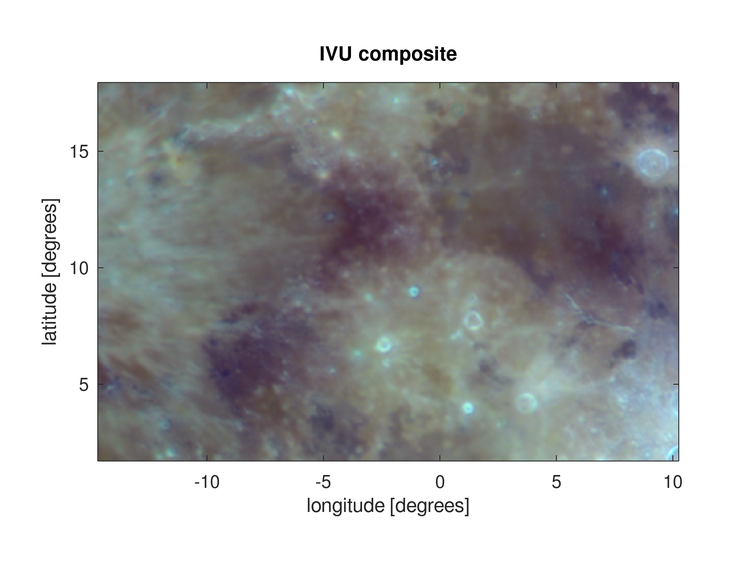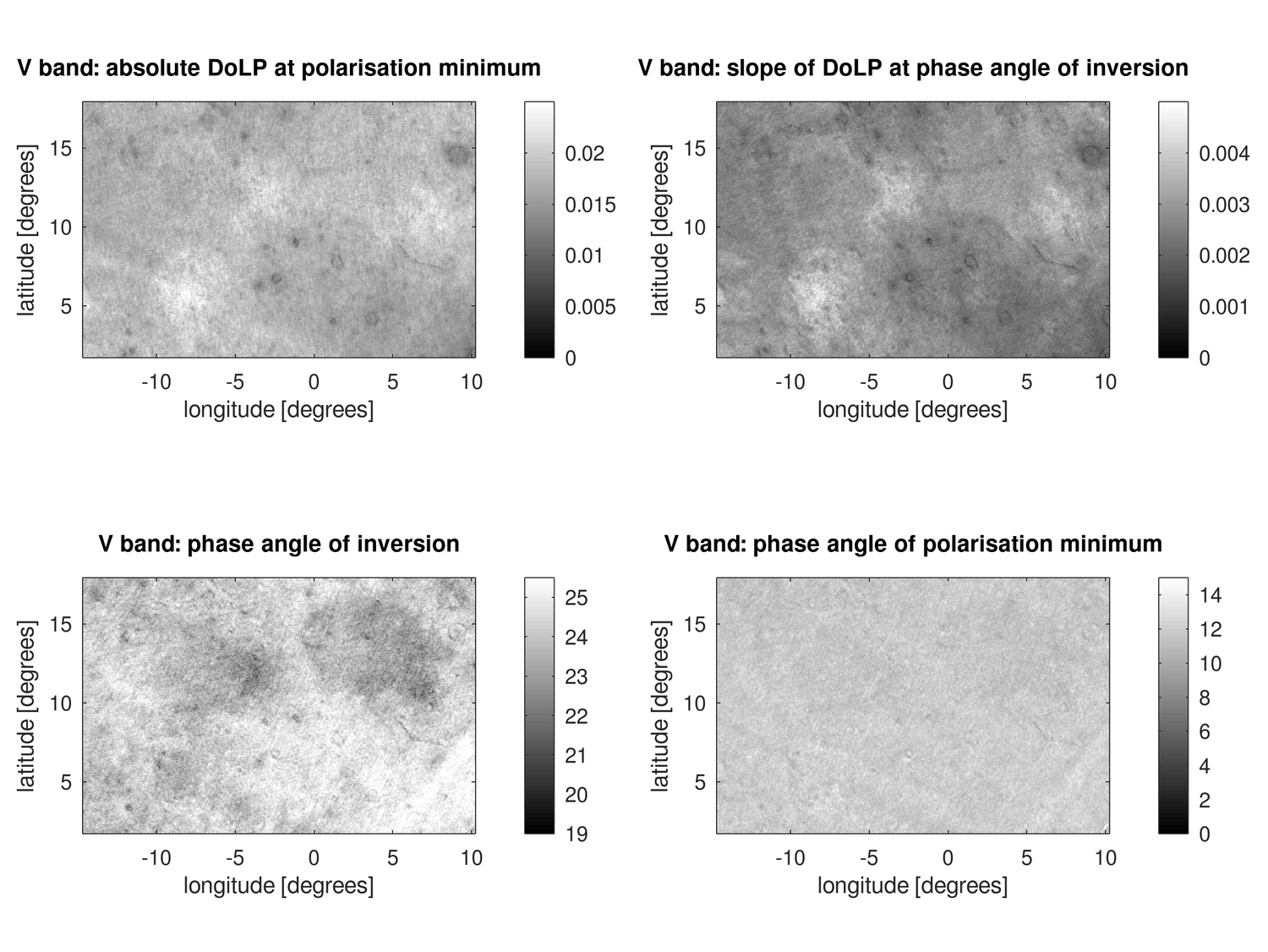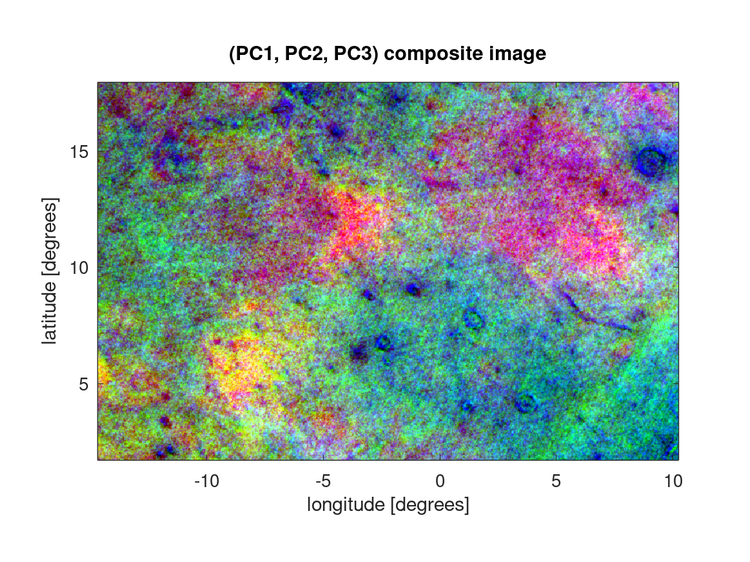Terrain-dependent spectral properties of lunar polarisation at small phase angles
- 1TU Dortmund University, Faculty of Electrical Engineering and Information Technology, Image Analysis Group, Dortmund, Germany (christian.woehler@tu-dortmund.de)
- 2Physical Research Laboratory, Ahmedabad, 380059, India
- 3Indian Institute of Technology Gandhinagar, Gandhinagar, 382055, India
Introduction
The polarisation of the sunlight reflected by the surface of the Moon contains information about the structural properties of the surficial regolith layer, such as the grain size and the microscale roughness [1, 2]. The internal structure or layering of regolith grains can be assessed using wavelength-dependent polarisation data [3]. Most of the existing lunar polarisation data were acquired at large phase angles exceeding approximately 23° in the visible wavelength range and were in part linked quantitatively to structural regolith properties based on laboratory experiments [e.g., 1, 2, 3, 4, 5]. At smaller phase angles, in the so-called ``negative polarisation branch'', the lunar polarisation is less well understood, and especially polarisation imaging data of high spatial resolution are scarce [e.g., 6, 7]. In this work, we present first results of a telescopic observation campaign aiming at the acquisition of multispectral (Johnson-Cousins UBVRI) imaging polarimetric data at small phase angles of a variety of typical lunar terrain types, including maria, highlands, pyroclastic deposits and fresh crater materials.
Data and Methods
The dataset analysed in this study was acquired during five nights between February 21st and 26th, 2024, at phase angles between 4° and 30° with a reflector telescope of 430 mm aperture and 3000 mm focal length at Mount Abu Observatory in Rajasthan, India. We used a monochrome the Imaging Source DZK 33UX250 industrial polarisation camera, which is constructed such that the individual sensor pixels are equipped with polarization filters rotated by 0°, 45°, 90° and 135°. In that way, for each 2 by 2 pixels neighbourhood of sensor pixels values for the intensity, degree of polarisation (DoLP) and angle of polarisation (AoLP) can be obtained [8]. The image scale is 0.9 km per pixel, the spectral filter set is Johnson-Cousins UBVRI ranging from the near-ultraviolet throughout the visible range into the near-infrared domain. To obtain a polarisation image, a set of 3500 individual camera frames was acquired, the individual sub-frames corresponding to the four polarization directions were extracted, and the sharpest 10% of the sub-frames were selected and stacked with the software Autostakkert3 [9].
So far, our analysis is restricted to the DoLP inferred from the stacked images. The telescopic data were georeferenced to the Lunar Reconnaissance Orbiter (LRO) Wide Angle Camera (WAC) mosaic as described in [4, 5], resulting in one image cube per wavelength channel containing the pixel-wise DoLP in dependence on the phase angle. To each pixel of each image cube, a third-degree polynomial with zero intercept was fitted [7], allowing for a computation of the absolute value Pmin of the minimal DoLP, the phase angle αmin at which the minimum occurs, the phase angle of inversion αinv of zero DoLP, and the slope h of the DoLP vs. phase angle curve at αinv [7]. The resulting 20 polarisation features were transformed to zero mean and unit standard deviation, and a Principal Component Analysis (PCA) [10] was applied. The small DoLP values in the negative polarisation branch have the effect that only the scores on the first 2-3 principal components are not dominated by noise.

Fig. 1: IVU composite of the study area. Colour saturation has been enhanced.

Fig. 2: Derived polarisation parameters in the V band.

Fig. 3: PCA composite image of the study area.
Results and Discussion
Our study area is located between the lunar craters Copernicus and Manilius and comprises the mare regions of Sinus Aestuum and Mare Vaporum, the neighbouring highland terrain, and the well-known regional pyroclastic deposits near Rima Bode, in Sinus Aestuum and in Mare Vaporum [e.g., 11]. For orientation, Fig. 1 depicts an RGB composite consisting of the I, V and U channels. Maps of the polarisation parameters Pmin, αmin, αinv and h in the V band are shown in Fig. 2 and the scores on the first three principal components in Fig. 3.
Fig. 2 shows that Pmin and h hardly differ between dark mature maria and brighter neighbouring highlands, but pyroclastic deposits stand out as positive anomalies and fresh craters as negative anomalies. Both parameters are correlated with the grain size inferred in [5] from the DoLP at large phase angles. The value of αinv is generally different for maria than for highlands, whereas αmin shows a weak dependence on the terrain. The PCA of the polarisation parameters indicates that each terrain type, in particular pyroclastic deposit terrain, is represented by a specific signature, corresponding to variations in the behaviour of the polarisation parameters. The peculiar behaviour exhibited by pyroclastic deposits in the negative polarisation branch, which is different from that of normal mature mare surfaces, may be due to unusual structural regolith properties as a consequence of their formation by explosive volcanism. Laboratory analyses and physical modelling studies are needed to quantitatively link the observed polarisation parameters in the negative branch to specific structural regolith parameters.
References
[1] Shkuratov, Y. and Opanasenko, N. (1992) Icarus 99(2), 468-484.
[2] Dollfus, A. (1998) Icarus 136(1), 69-103.
[3] Shkuratov, Y. et al. (2007) Icarus 187(2), 406-416.
[4] Bhatt, M. et al. (2023) A&A 674, A82.
[5] Wöhler, C. et al. (2024) AJ 167:187.
[6] Shkuratov, Y. et al. (1992) Icarus 95, 283-299.
[7] Opanasenko, N. et al. (2022) LPSC LIII, 1194.
[8] The Imaging Source (2019) https://www.theimagingsource.com/de-de/product/unique/33u-polarsens/?resolution=5013504&fps=75&mono_color=monochrome
[9] Kraaikamp, E. (2023) https://www.autostakkert.com
[10] Marsland, S. (2015) Machine Learning: An Algorithmic Perspective. 2nd ed., CRC Press.
[11] Gaddis, L. et al. (2003) Icarus 161(2), 262-280.
How to cite: Wöhler, C., Bhatt, M., Arnaut, M., Misra, D., Ganesh, S., and Bhardwaj, A.: Terrain-dependent spectral properties of lunar polarisation at small phase angles, Europlanet Science Congress 2024, Berlin, Germany, 8–13 Sep 2024, EPSC2024-995, https://doi.org/10.5194/epsc2024-995, 2024.